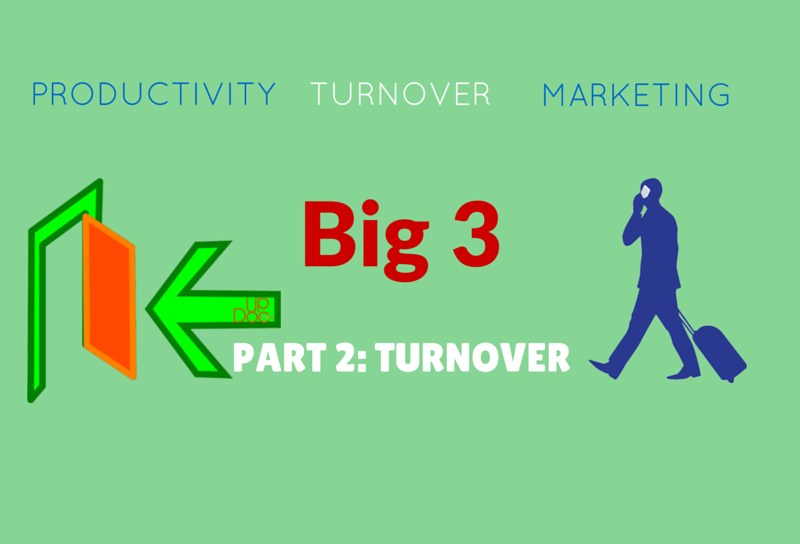
There is no doubt: Businesses of all sizes will need to make talent acquisition, mentoring, professional growth, transitions, transfers, promotions, exit, reacquisition, and work-life-balance of the utmost focus to optimize their company’s human capital & competitive advantage… to Attract and Keep Top Talent.
As for the Physical Therapy industry, Turnover & Talent Management will most definitely continue to be part of the Big 3 struggles of the profession. And, with no surprise, it has much to do with Part 1 of The Big 3: Productivity.
During a conversation with UpDoc Media Founder & Partner Dr. Gene Shirokobrod, we both noted that so very many companies at the APTA Private Practice Section conference in 2015 (#PPS2015) struggled with finding the right talent, at the right time, at the right place, for the right price, and for the right mutual reasons. In fact, it was one of the most universal business pains noted in the private practice community. And, they are not alone. Many in the corporate world I’ve conversed with complain much of the same thing — regardless of setting or even industry.
Finding good talent has become one of the biggest struggles for Physical Therapy in 2016. And, guess what? Forbes agrees.
From what I observed in the first half of the 2010s, the most common turnover causes in Physical Therapy have been:
1. Topside Downsizing
I’ve noticed a lot of companies have reevaluated their management structure. Their conclusions have overwhelmingly been this: “We’re too top heavy. Let’s downsize!” What is ironic about this is that companies are not only axing management positions, they are also reducing the size of the support staff & infrastructure which has been responsible for catalyzing their success to date. This has actually caused much of a decrease in general service production and has also caused a negative spiral in company morale en masse.
2. Unreasonable Productivity Expectations
We spoke on this in Part 1 of the Curse of the Big 3 in Physical Therapy. I’ve seen that in nearly all settings, productivity expectations have gotten so high that it becomes practically impossible to achieve without bending some (and, let us be honest)… and, even breaking rules. For this reason alone, I’ve seen a lot of physical therapists shift around to find working environments with realistic & ethical productivity policies. I do want to issue a word of caution to those systems with policies which are bending rules and breaking others; whistleblowing in physical therapy is on the rise. Traditionally speaking, whistleblowing in PT is rather rare… well, not anymore — not since the age of information and certainly not since the advent of social media. And, you know what they say about “one bad apple.” So, yeah… don’t ruin it for the rest of us.
3. The Leader Leaves and Everyone Leaves
I’ve also seen middle and upper management transition out for one reason or another. Sometimes it is just be the life cycle of their career/position. Other times, it could be that they wish to take a stand against something/for something, or, it could be that there were better opportunities. Nevertheless, what I’ve seen getting more common are mass exits when a good leader leaves. This type of turnover pattern also includes departmental reboots where the changing of the guards really is more like a changing of the dynasties. If you’re part of an old guard and the new boss of town is of another mindset, get ready… you’re already on your way out.
4. The Pay Is Better Elsewhere
As I noted in our Talent Management blog post, employees stand to gain upwards of 50% more in annual pay by leaving their jobs for better opportunities every two years. That, is a LOT of turnover… and, all simply because someone is willing to pay better. As for physical therapy, I’ve seen a lot of shift into home health and into SNF settings; away from outpatient, away from acute care, and even away from acute rehab. The fact of the matter is this: home health and SNF settings pay the best. As such, I’m expecting that once the home health & SNF job markets reach saturation, we’ll see the pendulum swing to the other side with outpatient and the other inpatient settings starting to pay better in a desperate effort to grab some help, any help!
5. Engagement Is Better Elsewhere
People need purpose in their work, especially in healthcare. Most professionals go into healthcare with a mission to help, serve, and make better the lives of others. This final and terribly common reason for turnovers of the last half decade resides in a shift in workforce culture. Millennials and generation x-ers want to be a part of something real, something significant, and something impactful. When organizations refuse to or are unable to engage their employees with purpose, they will lose those employees to companies who are willing to bring rhyme and reason to an employee’s responsibilities.
If you don’t have a solid strategy to mitigate turnover and maximize talent acquisition, your company is going to be in a world of hurt come just the next handful of years. Millennials and Generation X-ers are more than happy to leave less than fully satisfactory situations for what they consider to be better opportunities. At the replacement cost of 15% of annual salary equivalents, there’s a lot of money being wasted due to turnover and poorly designed management systems in acquiring talent. And, finally, consider that more and more managers are of the millennial and gen-x cloth. Therefore, with an increasing number of managers appreciating career mobility and career fluidity, it will not be very hard for the workforce to turn themselves over and find welcoming, greener pastures elsewhere.
If you wish to develop and implement management systems in acquiring and retaining good talent, you can start by reading our post here. And, of course, if you are interested in physical therapy specific strategies, metrics, and incentives — we would be more than happy to connect with you and see how we can best serve you.










